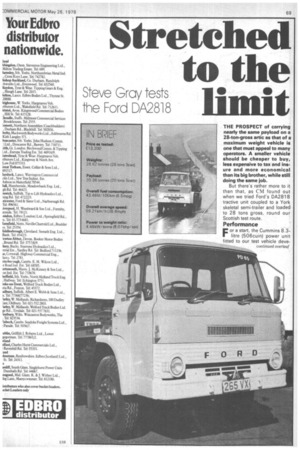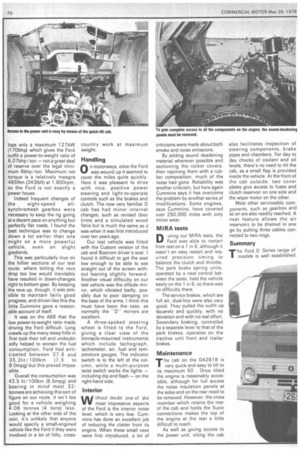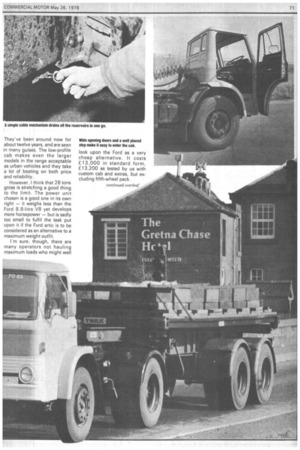Stretched to the
Page 71

Page 72

Page 73

If you've noticed an error in this article please click here to report it so we can fix it.
Stevo Grcy tests tho Ford 3A2818
Payload: 20 36 tonne.c. (70 tons 5cvv0 Overall fuel consumption: 43 46Iit." 100km (6 5nipg) Power to weight ratio: 4 4 6kW1 tonne (6 .0 7 bhp / ton)
THE PROSPECT of carrying nearly the same payload on a 28-ton-gross artic as that of a maximum weight vehicle is one that must appeal to many operators. A smaller vehicle should be cheaper to buy, less expensive to tax and insure and more economical than its big brother, while still doing the same job.
But there's rather more to it than that, as CM found out when we tried Ford's DA2818 tractive unit coupled to a York skeletal semi-trailer and loaded to 28 tons gross. round our Scottish test route.
Performance For a start, the Cummins 8.3U litre (506cuin) power unit fitted to our test vehicle deve
lops only a maximum 127kW (170bhp) which gives the Ford outfit a power-to-weight ratio of 6.07bhp/ton — not a great deal of reserve over the legal mini mum 6bhp/ton. Maximum net torque is a relatively meagre 465Nm (343Ibft) at 1,800rpm, so the Ford is not exactly a power house.
Indeed frequent changes of the eight-speed all. synchromesh gearbox were necessary to keep the rig going at a decent pace on anything but perfectly flat roads. I found the best technique was to change down a lot earlier than one might on a more powerful vehicle, even on slight gradients.
This was particularly true on the hillier sections of our test route, where letting the revs drop too low would inevitably have resulted in down-changes right to bottom gear. By keeping the revs up, though, it was possible to maintain fairly good progress, and driven like this the little Cummins gave a reasonable account of itself.
It was on the A68 that the low power-to-weight ratio made driving the Ford difficult. Long crawls up the many steep hills in first took their toll and undoubt edly helped to worsen the fuel consumption. Ford had anticipated between 37.6 and 35.21it/ 100km (7.5 to 8.0mpg) but this proved impossible.
Overall the consumption was 43.5 lit/100km (6.5mpg) and
bearing in mindmost 32
tonners are achieving this sort of figure on our route, it isn't too good for a vehicle weighing 4.06 tonnes (4 tons) less. Looking at the other side of the coin, it's unlikely that anyone would specify a small-engined vehicle like the Ford if they were involved in a lot of hilly, cross country work at maximum weight.
Handling On motorways, once the Ford was wound up it seemed to cover the miles quite quickly. Here it was pleasant to drive with nice, positive power steering and light-to-operate controls such as the brakes and clutch. The now very familiar D cab has had minor internal changes, such as revised door trims and a simulated wood facia but is much the same as it was when it was first introduced over ten years ago.
Our test vehicle was fitted with the Custom version of the cab and Bostrom driver's seat. I found it difficult to get the seat low enough to be able to see straight out of the screen without leaning slightly forward. Another visual difficulty on our test vehicle was the offside mirror, which vibrated badly, possibly due to poor damping on the base of the arms. I think this must have been the case, as normally the "D"' mirrors are excellent.
A three-spoked steering wheel is fitted to the Ford, giving a clear view of the binnacle-mounted instruments which include tachograph, tachometer, air, fuel and temperature gauges. The indicator switch is to the left of the column, while a multi-purpose twist switch works the lights — including dip and flash — on the right-hand side.
Interior ithout doubt one of the most impressive aspects of the Ford is the interior noise level, which is very low. Cummins has done an excellent job of reducing the clatter from its engine. When these small vees were first introduced, a lot of criticisms were made about both smoke and noise emissions.
By adding sound deadening material wherever possible and sectioning the rocker covers, then rejoining them with a rubber composition, much of the noise had gone. Reliability was another criticism, but here again Cummins says it has overcome the problem by another series of modifications. Some engines, says Cummins, have covered over 250,000 miles with only minor wear.
MIRA tests During our MIRA tests, the Ford was able to restart from rest on a 1 in 6, although it wasn't an easy restart and required precision timing to balance the clutch and throttle. The park brake spring units, operated by a neat control between the seats, held the vehicle easily on the 1 in 6, so there was no difficulty there.
The service brakes, which are full. air, dual-line were also very good. They pulled the outfit up squarely and quickly, with no deviation and with no real effort. Secondary braking, controlled by a separate lever to that of the park brakes, operates on the tractive unit front and trailer brakes.
Maintenance The cab on the DA2818 is very quick and easy to tilt to its maximum 50 . Once tilted the engine is reasonably accessible, although for full access the noise insulation panels at the sides and on the rear need to be removed. However, the cross -member which retains the rear of the cab and holds the Suzie connections makes the top of the engine at the rear a little difficult to reach.
As well as giving access to the power unit, tilting the cab also facilitates inspection of steering components, brake pipes and chambers. For day to day checks of coolant and oil levels, there's no need to tilt the cab, as a small flap is provided inside the vehicle. At the front of the cab outside, two cover plates give access to fuses and clutch reservoir on one side and the wiper motor on the other.
Most other serviceable components, such as gearbox and so on are also readily reached. A neat teature allows the air reservoir3 to be drained in one go by pulling three cables connected to two rings.
Summary
The Ford D Series range of models is well established.
They've been around now tor about twelve years, and are seen in many guises. The low-profile cab makes even the larger models in the range acceptable as urban vehicles and they take a lot of beating on both price and reliability.
However. I think that 28 tons gross is stretching a good thing to the limit. The power unit chosen is a good one in its own right — it weighs less than the Ford 8.8-litre V8 yet develops more horsepower — but is sadly too small to fulfil the task put upon it if the Ford artic is to be considered as an alternative to a maximum weight outfit.
I'm sure, though, there are many operators not hauling maximum loads who might well look upon the Ford as a very cheap alternative. It costs £13,000 in standard form, £13,200 as tested by us with custom cab and extras, but excluding fifth-wheel pack.
















































































































































































































